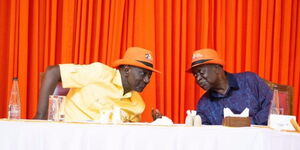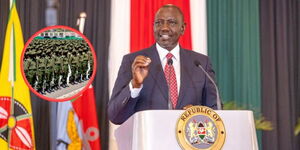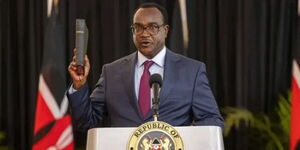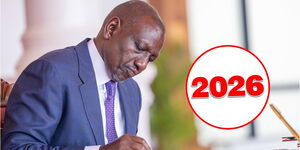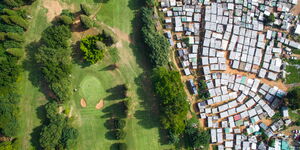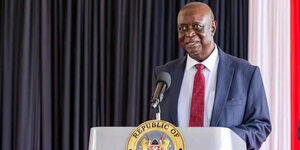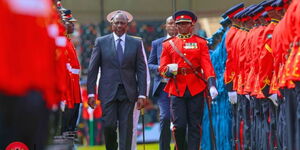Choices have consequences. Those were the words of Johnnie Carson, then United States Assistant Secretary of States, to Kenyans on Thursday, February 7, 2013. This was less than a month to the March 2013 polls.
Carson, while delivering the then President of the United States, Barack Obama's message calling for a peaceful election, told the electorate that the choices they made would determine a lot of things.
"Choices have consequences," Carson is quoted by the press saying. "We live in an interconnected world and people should be thoughtful about the impact that their choices have on their nation, on the region, on the economy, on the society and on the world in which they live. Choices have consequences.”
Carson's warning, which was three and a half weeks to the March 4, 2013 General Election, ruffled feathers among the political elites who saw it as political interference by America or an outright endorsement to one political faction.
At the time, Kenya was at a crossroads. The election was the first of its kind. It was the first under the 2010 Constitution dispensation and it was the first time Kenyans would vote in six leaders at a go.
It was also a historic election. The presidential poll was between Uhuru Kenyatta and Raila Odinga. Uhuru and his running mate, William Ruto, were facing crimes against humanity charges at the International Criminal Court (ICC). They had been charged with aiding and abetting violence that led to loss of 1,300 lives and displacement of over half a million Kenyans.
Despite all this, the duo - which branded itself as “Team Digital” - went on to win the poll. Although the victory was challenged at the Supreme Court, the petition was defeated.
A few minutes to midday on a sunny Tuesday, April 9, 2013, Uhuru Muigai Kenyatta and William Samoei Ruto were inaugurated. They took the oath of office and assumed the presidency.
With the gruesome campaigns and petition out of their way, It was time to fulfill their ambitious manifesto. A manifesto that promised to transform Kenya from a third world country to a developing country. A manifesto that promised to grow the economy by double digit. A manifesto that promised modern, fully equipped referral hospitals in every county, among many other grand promises. Kenyans were by then ranked among the most optimistic lot by a June 2013 report by World Bank.
Wastage and Deep Rooted Corruption
In what was termed as a slip of the tongue, President Kenyatta said during a morning show with vernacular radio stations in January 2021 that Kenya loses Ksh2 billion daily to corruption. A look at the major scandals that have faced Kenya since the President took power shows that he could have been right.
In the year 2015, two years after Mr Kenyatta took over the country’s leadership, the first case of mega corruption was reported at the National Youth Service (NYS) which was under the Ministry of Devolution headed by the then Cabinet Secretary, Anne Mumbi Waiguru.
The Auditor General report noted that Ksh1.3 billion was lost through irregular payments made to 11 non-existent companies.The country had allegedly lost Ksh791.4 million through flawed procurement processes in the construction of a road in Kibera, all the money, the audit showed, was wired to the accounts of Josephine Kabura, who is facing charges in court. She was also meant to benefit from the attempted theft of Ksh695 million according to the audit report.
What were the most peculiar spendings?
On November 9, 2015, the Ministry of Devolution under CS Waiguru and Principal Secretary, Eng Peter Mangiti, agreed that it had spent hundreds of thousands of shillings on sex toys which it indicated were to be used for HIV/AIDs demonstrations.
The Ministry also agreed to purchasing condom dispensers and anti-virus for office computers at inflated prices.
It also agreed that it had spent taxpayers’ money on some unnecessary expenses such as a guitar that cost Ksh235,000, a monitor for use in meetings at a cost of Ksh1.7 million.
As if this was not enough, the same National Youth Service Lost another Ksh10 billion in 2018 through flawed procurement systems. The government agency paid billions of shillings to shrewd business people for goods and services not supplied.
In total, the NYS lost over Ksh11 billion. Waiguru denied any involvement in the scandal and has never been charged while Mangiti was charged with 23 others but was later acquitted in one of the many NYS cases.
On October 26, 2016, Kenyans learnt that the Ministry of Health (MOH) lost 21 per cent of its budget through NYS-style theft that came to be known as the “Mafia House Scandal”. According to the Auditor General, MOH allegedly lost Ksh5 billion of the Ksh23.5 billion allocated to it by the National Treasury in the 2015/2016 Financial Year.
The scandal involved diversion of funds, double payments for goods, and manipulation of the Integrated Financial Management Systems (IFMIS).
“The small sample covered is an indicator that there could be a wider scheme wherein the Ministry incurred huge losses to the detriment of service delivery to the public,” the Auditor General report addressed to the then Health Cabinet Secretary, Cleopa Mailu, stated.
On June 10, 2015, the Council of Governors under Peter Munya called on the Ethics and Anti-Corruption Commission (EACC) to investigate the controversial medical equipment leasing deal that cost taxpayers Ksh38 billion.
Munya announced that governors were forced to sign the deal and pay the amounts from the county coffers despite not being involved in the negotiations.
In August 2020 at the height of the Covid-19 pandemic, the Kenya Medical Supplies Authority (KEMSA) hit the headlines after it lost Ksh7.8 billion. EACC in its preliminary findings showed that several laws on public procurement were flouted during the awarding of the tenders.
The amount, according to the Auditor General, was paid to high ranking government officials to supply Personal Protective Equipment (PPEs) for medical workers across the country.
In total, the Ministry of Health lost at least Ksh50.8 billion.
The Dams Scandal
In mid-2017, Deputy President William Ruto led a team of MPs, governors and Senators to Arror forest in Elgeyo Marakwet county. The DP had flown the politicians there to show them where a multi-billion dam would be constructed.
A second dam would be constructed down the valley at Kimwarer Talaal on the Kimwarer River in Keiyo North. The two dams were part of Jubilee’s ambitious manifesto to ensure sufficient supply of drinking and irrigation water.
A year later in late 2018, after Ruto was re-elected alongside his boss, Kenyatta, the Auditor General report indicated that the country had lost Ksh19 billion through inflated tenders.
The audit report detailed how the government paid Ksh63 billion for supplies whose actual cost was Ksh46 billion.
Most Expensive Railway Line?
Immediately the duo took over power, they embarked on one of their most ambitious projects - The Standard Gauge Railway that was touted as the game change in the movement of goods and passengers in the region. During the construction of the Standard Gauge Railway (SGR), the Auditor General report indicated that Ksh35 billion was misappropriated through inflated compensation to land owners whose parcels were acquired to pave the way for the project.
In 2020, the National Hospital Insurance Fund (NHIF) lost Ksh1.1 billion through an Integrated Revenue Collection Management System that was being run by a local fin-tech.
The scandal saw 21 people including then NHIF Chief Executive Officer, Simeon Ole Kirgotty, charged with intent to defraud the government of Ksh1.1 billion.
What can Ksh162.9 billion do?
These mega scandals that rocked Mr Kenyatta’s administration are estimated to have led to a loss of at least Ksh162.9 billion. What can this money do?
To put things into perspective, this amount could construct two Nairobi Expressways each at a cost of Ksh81.5 billion.
According to the County Government of Nyeri, the Naro Moru Level IV hospital was priced at Ksh329 million construction cost and Ksh300 million to fully equip it. This means that the ksh162.9 billion would construct and fully equip 258 level four hospitals. This would translate to five hospitals in every county.
In the Financial Year 2022/2023, the National Treasury allocated Ksh2.5 billion to Free Primary Education (FPE). In context, the misappropriated Ksh162.9 billion would fund FPE for 65 years if the budget was to remain the same.
In this same Financial Year, the government allocated Ksh175 million to Youth Enterprise Development Fund, Ksh170 million to Women Enterprise Fund, and Ksh92 million to Youth Employment and Enterprise Fund. These three funds received a cumulative allocation of Ksh437 million.
The Ksh162.9 billion lost would fund the three government agencies for 372 years.
As the country heads to another election full of promises by the same politicians, Kenyans.co.ke reminds you that choices have consequences and all Kenyans should vote wisely.



